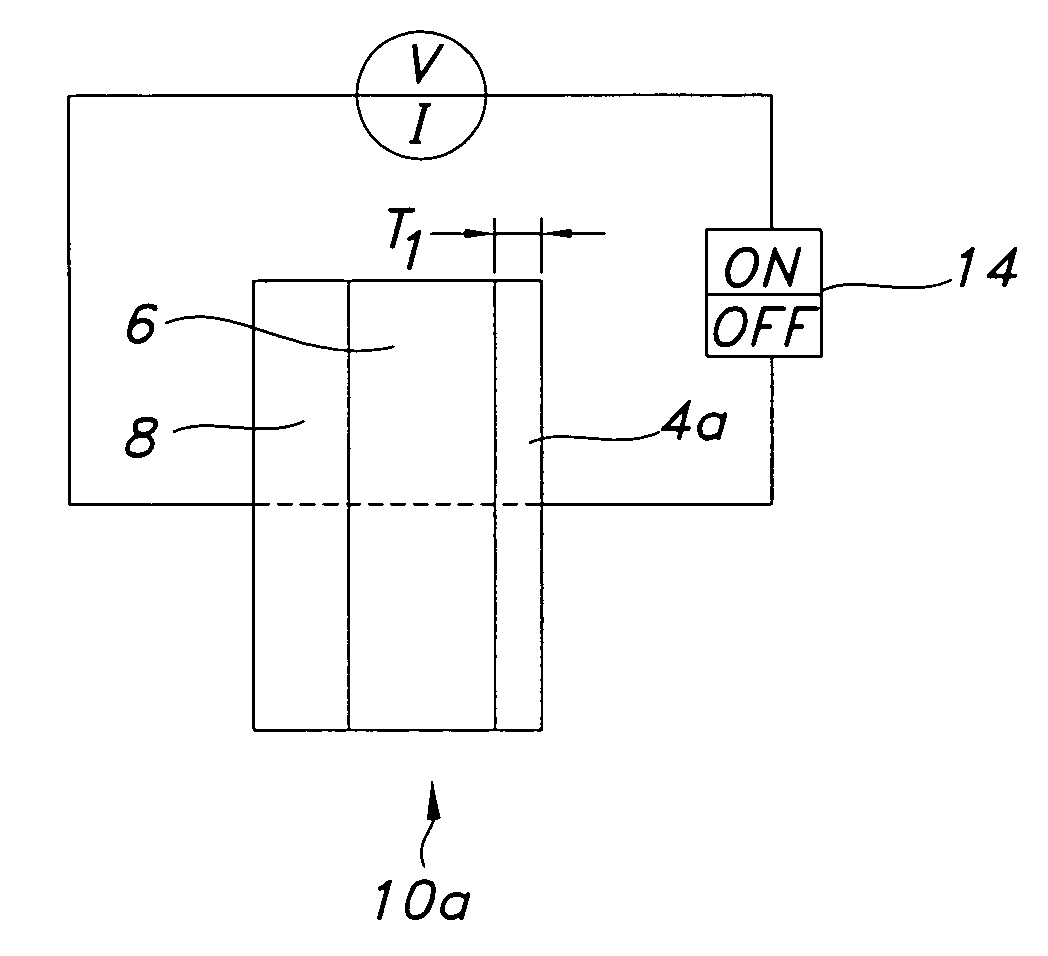Method and apparatus for corrosion detection
a technology of corrosion detection and apparatus, applied in the direction of resistance/reactance/impedence, measurement devices, instruments, etc., can solve the problems of increasing the impedance the loss of material the increase of the material loss across the thickness of the sensor element, so as to inhibit the current flow through the device, reduce the impedance between the sensor and the backing element, and the effect of noise resistan
- Summary
- Abstract
- Description
- Claims
- Application Information
AI Technical Summary
Benefits of technology
Problems solved by technology
Method used
Image
Examples
example 1
[0024]An aluminum foil of thickness 0.2 mm was exposed to 2.5M NaCl containing 1.25 g / l CuCl2. The resistance between the Al foil exposed to solution and another Al foil not exposed to solution are measured as a function of time. Initially the resistance is very high (in fact it is higher than the maximum value that the instrument can measure 110 MΩ). When corrosion has penetrated through the thickness of the exposed foil, there is a sharp change in resistance as seen in FIG. 2. Thus the time for corrosion to proceed through a given thickness can be determined. The time for corrosion to proceed through various thickness can also be measured to determine the kinetics of corrosion propagation as shown in FIG. 2 where foils of two different thickness were tested 0.1 mm and 0.2 mm.
example 2
[0025]Copper foils of two different thickness were tested in the solution chemistry shown in Table 1 below. An anodic potential of 0.5 V SCE and 1V SCE was applied using a three electrode setup. FIG. 3 is a graphical representation of potential and current versus time raw data plot illustrating the potential steps applied to the copper sample over the course of the experiment. The resistance is also measured and a change in resistance is indicative of corrosion penetrating through the thickness of the foil as shown in FIG. 4. In another set of experiments on copper foils of two different thickness (0.08 mm and 0.18 mm), potential steps were applied shown in FIG. 5. FIG. 6 demonstrates that resistance changes sharply when corrosion penetrates through the thickness of the foil.
[0026]
TABLE 1Solution chemistry used in copper foil experiment.CaCl2666ppmMgCl2•6H2O610ppmNa2CO3100ppmNa2SO4200ppmPO42− (as Na4P2O7)2.5ppmPO42− (as NaHPO4)15ppmHPS10ppm
[0027]Turning now to FIG. 7, which illustra...
example 3
[0030]A tantalum wire of 0.48 mm thickness was exposed to a methanol solution containing 0.93 wt % water and 0.5 wt % HCl. A potential of 1000 mV Ag / AgCl / 0.1M KCl was applied to accelerate corrosion. The resistance of the wire was measured continuously. Initially when the wire was continuous, the resistance was low as shown in FIG. 8. However, when pits or corrosion propagate through the diameter of the wire there is a sharp change in the resistance of the wire from about 10Ω to about 10MΩ.
[0031]It is noted that the embodiment of FIG. 7 differs from the embodiments of FIGS. 1A, 1B and 9 in that electrical current initially flows through the sensor elements 40a, 40b, and 40c from the time the device is first installed in the fluid containing system, and current will continue to flow through the sensor elements 40a, 40b and 40c until the loss of thickness in the respective sensor elements due to corrosive activity. As shown in FIG. 9, the 25 and 30 micron strips have failed, while cor...
PUM
| Property | Measurement | Unit |
|---|---|---|
| resistance | aaaaa | aaaaa |
| thickness | aaaaa | aaaaa |
| thickness | aaaaa | aaaaa |
Abstract
Description
Claims
Application Information
 Login to View More
Login to View More - R&D
- Intellectual Property
- Life Sciences
- Materials
- Tech Scout
- Unparalleled Data Quality
- Higher Quality Content
- 60% Fewer Hallucinations
Browse by: Latest US Patents, China's latest patents, Technical Efficacy Thesaurus, Application Domain, Technology Topic, Popular Technical Reports.
© 2025 PatSnap. All rights reserved.Legal|Privacy policy|Modern Slavery Act Transparency Statement|Sitemap|About US| Contact US: help@patsnap.com



